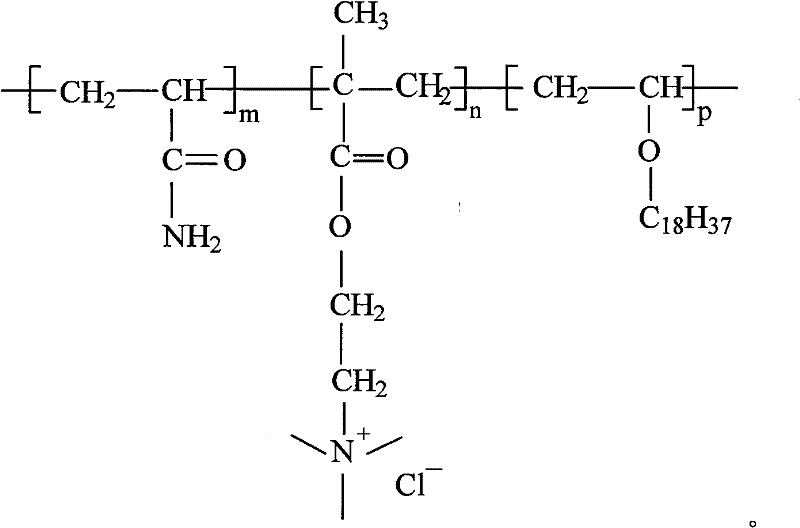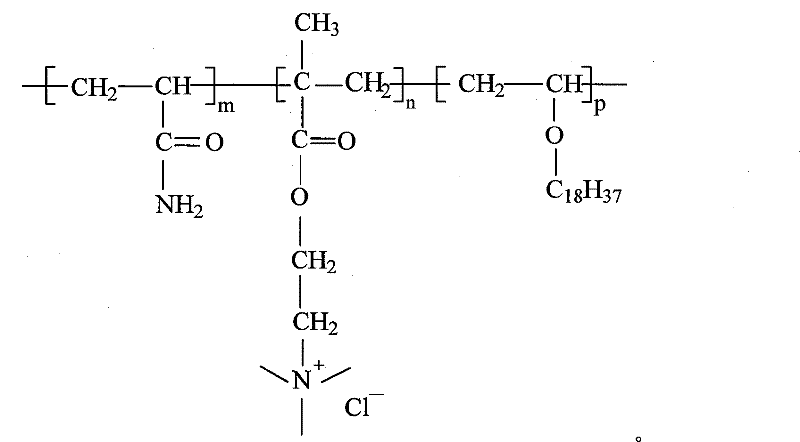Hydrophobic cation polymeric flocculant preparation method
A polymer flocculant, cation technology, applied in the direction of dewatering/drying/concentrating sludge treatment, etc., can solve the problems such as the inability to effectively improve the dewatering rate of the sediment, the difficulty of rapid drying of the dredged sediment, and the weak hydrophobicity. , to achieve the effect of wide range of use, good flocculation effect and strong hydrophobicity
- Summary
- Abstract
- Description
- Claims
- Application Information
AI Technical Summary
Problems solved by technology
Method used
Image
Examples
Embodiment 1
[0023] Add acrylamide, methacryloxyethyl trimethyl ammonium chloride, cetyl trimethyl ammonium bromide, urea, and deionized water into a four-necked flask, stir and increase the temperature and add octadecyl vinyl Ether, after vigorously stirring, add initiator (a mixture of ammonium persulfate and sodium bisulfite with a mass ratio of 2:1), and react for 4 hours to prepare a hydrophobic cationic polymer flocculant. Acrylamide and methacrylic acid are involved in the reaction. The total amount of acyloxyethyl trimethyl ammonium chloride and octadecyl vinyl ether is recorded as the total monomer content. The acrylamide content accounts for 89.5 mol% of the total monomer content. The content of base ammonium chloride accounts for 10 mol% of the total monomers, the content of cetyltrimethylammonium bromide accounts for 6wt% of the total monomers, and the urea content accounts for 2wt% of the total monomers. The weight ratio of deionized water is 20:80, the octadecyl vinyl ether co...
Embodiment 2
[0031] Add acrylamide, methacryloyloxyethyl trimethyl ammonium chloride, cetyl trimethyl ammonium bromide, urea, and deionized water into a four-neck flask, stir and heat up and add octadecyl acrylate, strong After stirring, add an initiator (a mixture of ammonium persulfate and sodium bisulfite with a mass ratio of 2:1), keep the reaction for 4 hours to prepare a hydrophobic cationic polymer flocculant, and participate in the reaction of acrylamide and methacryloxy ethyl The total amount of trimethyl ammonium chloride and octadecyl vinyl ether is recorded as the total monomer content. The acrylamide content accounts for 86.5 mol% of the total monomer content. Methacryloxyethyl trimethyl chloride The ammonium content accounts for 10mol% of the total monomers, the cetyltrimethylammonium bromide content accounts for 6wt% of the total monomers, and the urea content accounts for 2wt% of the total monomers. The total monomers and deionized water The weight ratio of octadecyl vinyl e...
Embodiment 3
[0039] Add acrylamide, methacryloyloxyethyl trimethyl ammonium chloride, cetyl trimethyl ammonium bromide, urea, and deionized water into a four-neck flask, stir and heat up and add octadecyl acrylate, strong After stirring, add an initiator (a mixture of ammonium persulfate and sodium bisulfite with a mass ratio of 2:1), keep the reaction for 4 hours to prepare a hydrophobic cationic polymer flocculant, and participate in the reaction of acrylamide and methacryloxy ethyl The total amount of trimethyl ammonium chloride and octadecyl vinyl ether is recorded as the total monomer content. The acrylamide content accounts for 56.5 mol% of the total monomer content. Methacryloxyethyl trimethyl chloride The ammonium content accounts for 40mol% of the total monomers, the cetyltrimethylammonium bromide content accounts for 6wt% of the total monomers, and the urea content accounts for 2wt% of the total monomers. The total monomers and deionized water The weight ratio of octadecyl vinyl e...
PUM
| Property | Measurement | Unit |
|---|---|---|
| solid content | aaaaa | aaaaa |
Abstract
Description
Claims
Application Information
 Login to View More
Login to View More - R&D
- Intellectual Property
- Life Sciences
- Materials
- Tech Scout
- Unparalleled Data Quality
- Higher Quality Content
- 60% Fewer Hallucinations
Browse by: Latest US Patents, China's latest patents, Technical Efficacy Thesaurus, Application Domain, Technology Topic, Popular Technical Reports.
© 2025 PatSnap. All rights reserved.Legal|Privacy policy|Modern Slavery Act Transparency Statement|Sitemap|About US| Contact US: help@patsnap.com



